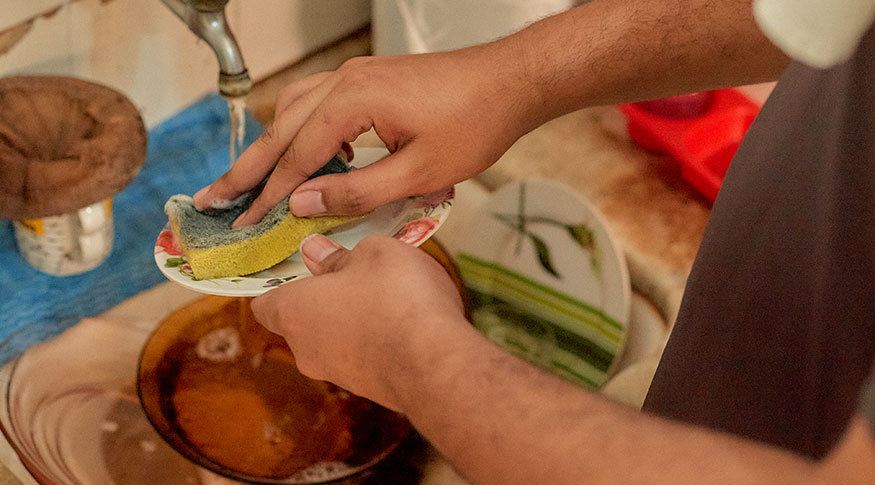Other forms of work
In 2022, women dedicated more 9.6 weekly hours than men to household tasks and care of persons
August 11, 2023 10h00 AM | Last Updated: August 16, 2023 05h29 PM
Highlights
- In 2019, women dedicated more 10.6 hours than men to household tasks and/or care of persons. In 2022, that difference was 9.6 hours.
- Despite the slight reduction, 92.1% of women aged 14 years and over carried out household tasks and/or care of persons in 2022, whereas only 80.8% of men in this age group were involved in these activities. Men in the Northeast Region registered the lowest achievement rate: 73.9%.
- The division of the household tasks remains unequal even among workers: on average, employed women dedicated more 6.8 hours than employed men to household tasks and/or care of persons in 2022.
- In Brazil, the achievement rate of household tasks among persons aged 14 years and over changed from 85.9% in 2019 to 85.4% in 2022, or the equivalent to 148.1 million persons in this age group carrying out those tasks.
- The achievement of household tasks was higher among men with complete higher education (86.2%) and lower among those without any education or with incomplete primary education (74.4%).
- Women who self-declared as black recorded the highest achievement rate of household tasks (92.7%).
- The achievement rate of care of persons fell from 33.3% in 2019 to 29.3% in 2022, or the equivalent to -5.3 million persons.
- Considering care of persons in the household in this period, care of children aged between 0 and 14 years reduced and care of residents aged between 15 and 59 years and seniors increased.
- The achievement rate of voluntary work was 4.2%, the equivalent to 7.3 million persons aged 14 years and over involved in this activity. Between 2019 and 2022, this achievement rate increased in the five Major Regions.

In 2022, the population aged 14 years and over dedicated, on average, 17 weekly hours to household tasks and/or care of persons, being 21.3 weekly hours for women and 11.7 hours for men. These data come from the Other forms of work module of the 2022 Continuous National Household Sample Survey, which raised data on care of persons, household tasks, production for own consumption and voluntary work.
In 2022, 148.1 million persons aged 14 years and over carried out household tasks in their own households or in relatives´ households, the equivalent to 85.4% of this population, slightly below the rate estimated in 2019 (85.9%). While 91.3% of women carried out some activity related to household tasks, this proportion was 79.2% among men in 2022. “Although the contingent of those who carry out household tasks increased (2.4%), the rate dropped because the population aged 14 years and over increased even faster (2.9%),” explains Alessandra Brito, an IBGE analyst.
Due to the COVID-19 pandemic, the theme Other Forms of Work was not investigated in 2020 and 2021, resuming in 2022. The results incorporate the re-weighting of the Continuous PNAD occurred in 2021, whose data take into account the total population by sex and age group based on the 2010 Population Census.
Between 2019 and 2022, the decrease of 1.1 percentage points (pp) in the rate among women was the factor that mostly contributed to the negative change of the achievement rate of household tasks in Brazil. “Yet, it is not possible to state that the division of tasks became more balanced, because the rate remained stable among men, changing from 79.0% to 79.2% in the period,” says the survey´s analyst.
Men in the Northeast have the lowest participation in household tasks
The Northeast registered the lowest achievement rates of household tasks, for the total (81.1%), for men (71.6%) and for women (89.7%). That region also recorded the biggest difference between the achievement rates of household tasks by sex (more 18.1 pp for women) and the South, the smallest one (more 9.3 pp for women).
Black women are those who mostly carry out household tasks
The achievement rates of household tasks of white (90.5%), black (92.7%) or brown (91.9%) women are always higher than those of men of the same groups of color or race (80.0%, 80.6% and 78.0%, respectively).
Youngsters aged between 14 and 24 years carry out less household tasks, with a rate of 77.6%, a percentage that reaches 89.3% among adults between 25 and 49 years. The lowest achievement rate occurred among men between 14 and 24 years (69.3%) and the highest one, among women between 25 and 49 years (95.1%). The group of women aged 50 years and over reported the biggest reduction in the achievement rate between 2019 and 2022 (-1.7 pp).
“Men and women in this age bracket registered an important reduction in the rate as the contingent that carries out household tasks (6.7%) grew slower than the population in this age group (8.5%),” completes Alessandra Brito.
The lowest achievement rates of household tasks were of the group of sons (daughters) or stepsons (stepdaughters): 74.4%, being 67.0% for men and 83.8% for women.

More educated men participate more in household tasks
In 2022, the achievement rate of household tasks was 81.0% among persons without any education or with incomplete primary education and 90.2% among those with complete higher education, a difference of 9.2 pp. The difference is even bigger among men (11.8 pp), whereas this difference was 5.2 pp among women.
The achievement of household tasks is higher among men with complete higher education (86.2%) and lower among those without any education or with incomplete primary education (74.4%).
Small repairs is the only activity in which men prevail
Between 2019 and 2022, the activities that mostly grew were taking care of pets (3.3 pp), cleaning or maintaining clothes and shoes (2.8 pp), and doing small repairs or maintenance of households, cars, household appliances or other equipment (2.1 pp). On the other hand, the activity of shopping remained stable. “Nearly all the activities grew, possibly caused by the pandemic,” highlights the survey´s analyst.
In 2022, the activities related to feeding, cleaning or maintenance of clothes and shoes, and household cleaning were still concentrated on women. In small repairs or in the maintenance of the household, men (60.2%) recorded the highest percentage of achievement than women (32.9%).

Care of persons retreated from 33.3% in 2019 to 29.3% in 2022
In 2022, 50.8 million persons aged 14 years and over took care of residents in their households or in non-resident relatives´ households, with an achievement rate of 29.3%, 4 pp (less 5.3 million) below that in 2019 (33.3%).
“This reduction might be related to a decreasing need to take care of children, due to less fertility in the pandemic. Or it might be linked with the increase in employment in the labor market in 2022, reducing the availability of persons for taking care,” analyzes Alessandra Brito. The achievement rate of such care is different according to sex: 34.9% for women and 23.3% for men in 2022.
Black (29.4%) and brown (31.0%) persons have higher achievement rates than white persons (27.4%). While 38.0% of brown women and 36.1% of black women took care of persons in 2022, the rate was 31.5% among white women.
Household tasks and care of residents demand 17 weekly hours
In 2022, 150.1 million persons aged 14 years and over carried out some activity related to household tasks in their households or in relatives´ households and/or care of residents in their households or in non-resident relatives´ households, which corresponds to an achievement rate of 86.6% for Brazil. The South Region registered the highest achievement rate (88.9%) and the Northeast, the lowest one (82.7%).
In 2022, the average hours dedicated to such activities was estimated at 17.0 weekly hours, slightly above that in 2019 (16.8 hours). Unemployed women dedicated, on average, 24.5 weekly hours to household tasks and/or care of persons, whereas unemployed men dedicated only 13.4 hours in 2022.
Employed women also concentrate household tasks and care of persons
Employed women dedicated, on average, more 6.8 hours than employed men to household tasks and/or care of persons. The achievement of these activities affects employment of women as well. On average, men tend to work more hours than women, both among persons who carried out such activities (more 4.6 weekly hours for men) and among those who did not carry them out (more 2.7 weekly hours for men).
Achievement of production for own consumption did not retreat only in the North
In 2022, 11.8 million persons dedicated to the production for their own consumption. Between 2019 and 2022, the participation in this activity reduced in four out of five Major Regions. In this period, only the North Region increased the number of persons working in the production for their own consumption (from 1.3 million to 1.4 million), though the participation rate remained stable at 9.7%.

In 2022, 7.3 million persons carried out voluntary work
The achievement rate of voluntary work was 4.2%, the equivalent to 7.3 million persons aged 14 years and over. The Northeast recorded the lowest achievement rate of voluntary work (3.3%) and the South, the highest one (4.6%). Between 2019 and 2022, the accomplishment of this activity grew in all the regions, especially in the Central-West (0.6 pp).
In 2022, 86.4% of persons who carried out voluntary work did it through a company, organization or institution, a proportion 4.2 pp lower than that estimated in 2019, which shows a relevant increase in the individual form of this activity.
“Although voluntary work through companies, organizations or institutions remains the major form of accomplishment, this proportion decreased in relation to the individual voluntary work, which might point out a new pattern of post-pandemic voluntary work,” assesses Alessandra Brito.
The frequency of the voluntary work changed as well. While the parcel of those carrying out voluntary work four or more times per month reduced, voluntary work carried out once per month increased.




















